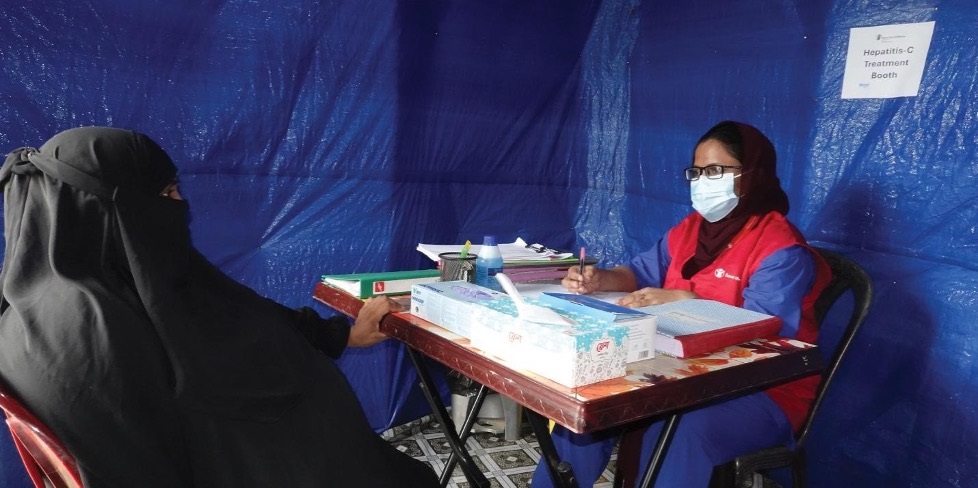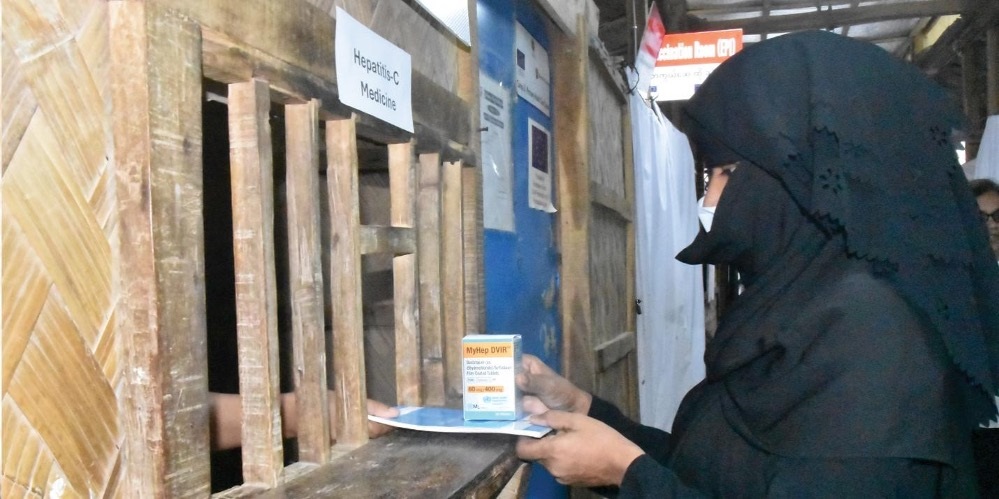/data-and-analytics-(dna)/data-exchange-(dex)/who-presence-in-countries--territories-and-areas.tmb-1920v.jpg?sfvrsn=f1146a2_2)
Combating the hepatitis C crisis among Rohingya refugees in Bangladesh
Stronger WHO country presence for a healthier and safer world
Joint Outcome 4.1.
Equity in access to quality services improved for noncommunicable diseases, mental health conditions and communicable diseases, while addressing antimicrobial resistance
The prevalence of the hepatitis C virus (HCV) in Bangladesh is under 1%, but rates among Rohingya refugees in Cox’s Bazar camps are 10 times higher.1 Studies show prevalence ranging from 13.2% to 19.6% since the 2017 influx1,2,3, with 8% of pregnant women testing positive for HCV antibodies. 4World Health Organization (WHO) surveillance also highlights concerns about vertical transmission to infants. 5With one in five refugees affected, Cox’s Bazar Rohingya camps have the highest global HCV prevalence.6 In response, WHO launched a comprehensive HCV surveillance and treatment programme on 6 March 2024.7 By 12 December 2024, 10 768 individuals had been screened, 4195 HCV-positive cases identified, 764 patients treated, and post-treatment samples from 133 patients had tested negative, showing promising results in controlling HCV in the refugee population.
WHO's interventions in the HCV response in the Cox’s Bazar refugee camps represent a crucial and adaptive effort to address the high burden of the disease among the 1 million Rohingya refugees. This public health challenge is met through a multifaceted approach that integrates surveillance with treatment services, ensuring equity and access for refugees.
The programme, supported by key international partners including the European Civil Protection and Humanitarian Aid Operations, the United States Department of State Bureau of Population, Refugees, and Migration, the Norwegian Agency for Development Cooperation and WHO’s Regional Office for South-East Asia, is tailored to the unique health needs of the refugee population.

A patient receives critical triage care to assess and address urgent medical needs in the Rohingya refugee camps.
WHO plays a pivotal role in leading efforts to scale up HCV testing and treatment, collaborating closely with stakeholders such as the Government of Bangladesh, United Nations agencies, international nongovernmental organizations and health experts.
The programme began with two treatment centres and is currently being expanded to five more, supported by partners including the International Organization for Migration, Save the Children, the Bangladesh Rural Advancement Committee, the International Rescue Committee and the United Nations High Commissioner for Refugees. Médecins Sans Frontières also operates two treatment centres and is in the process of adding a third. Together, these efforts provide services through five treatment centres inside the camps, ensuring coverage for the entire population across 33 refugee camps. This multi-stakeholder collaboration ensures efficient operations, with WHO leading and coordinating the comprehensive response.
“We aim to increase access to and availability of treatment in health facilities within the camps. This initiative is a testament to WHO’s steadfast dedication to inclusiveness and the right to health, guaranteeing that, even under the most difficult conditions, everyone can receive the care they need.”
Dr Jorge Martinez, Head of Sub-Office, WHO Cox’s Bazar
Key actions taken include access to early diagnosis delivered through 110 camp-level health care facilities, including 18 primary health care centres designated as sentinel sites for the collection of HCV samples for ribonucleic acid reverse transcription polymerase chain reaction (RNA RT-PCR) diagnostic testing.
The WHO-supported Institute of Epidemiology, Disease Control and Research field laboratory at Cox’s Bazar Medical College ensures accurate and timely diagnoses. WHO’s continuous coordination with stakeholders, through the establishment of a technical task force, has streamlined the response and allowed for adjustments based on local needs, addressing the unique challenges of providing care in a refugee setting.
The programme operates under the oversight of the Office of the Refugee Relief and Repatriation Commissioner, which has expressed hope that the collective efforts of various partners will reduce HCV prevalence and enhance the well-being of refugees. Dr Jorge Martinez, Head of the WHO Sub-Office in Cox’s Bazar, emphasized the organization’s steadfast commitment to collaborating with health partners to alleviate the burden of HCV among Rohingya refugees and the surrounding host communities.

An HCV-confirmed patient receives medication from a facility’s medicine dispenser in the Rohingya refugee camps.
As of 12 December 2024, 10 768 individuals have been screened for HCV and Hepatitis B using rapid diagnostic tests, with 4195 testing positive for HCV. Among 4226 pregnant women screened, 618 (14.6%) tested positive for HCV. Of those who tested positive, 1874 were tested for HCV RNA, with 1263 (67.3%) showing active infections. Treatment has been initiated for 764 patients, and 133 post-treatment samples have shown a satisfactory treatment response with sustained virological response at post-treatment week 12 (SVR12), highlighting the effectiveness of the programme in improving health outcomes.
“Improving access to HCV testing, treatment and care among the most vulnerable, including pregnant women, children and adolescents, is important as part of viral hepatitis elimination as a public health threat in the WHO South-East Asia Region..”
Dr Po-Lin Chan, WHO Regional Adviser on HIV, Hepatitis and STIs
The success of this initiative reflects the adaptability of WHO’s approach, which has been responsive to both the immediate and evolving needs of the refugee population. Lessons learned from this programme emphasize the importance of continuous monitoring, collaboration and flexibility in adapting strategies. WHO’s efforts have contributed to reducing the health burden of HCV and improving the well-being of refugees, while also building capacity within the local health system to manage the disease in the long term. This programme demonstrates WHO's commitment to sustainable, inclusive health care solutions for vulnerable populations, ensuring that even under the most challenging conditions, all individuals have access to the care they need.
WHO will continue to scale up HCV surveillance and treatment in Cox’s Bazar, aligning efforts with Bangladesh’s national health priorities, and it will focus on further reducing the disease burden among the refugee population. By expanding access to screening and treatment, the programme aims to make significant strides towards eliminating viral hepatitis as a public health threat. This initiative serves as a model for adaptable, collaborative health responses, demonstrating the power of multi-stakeholder coordination in addressing the health needs of vulnerable populations.
